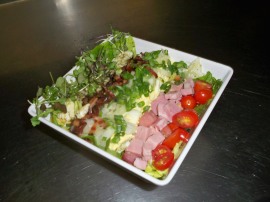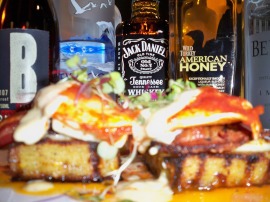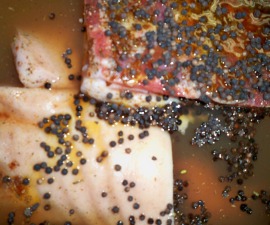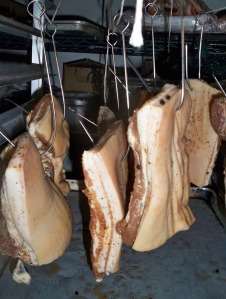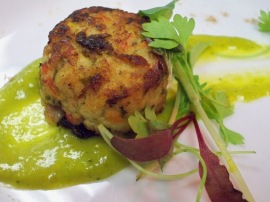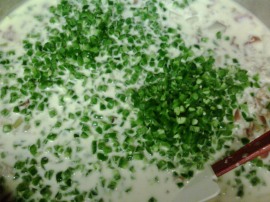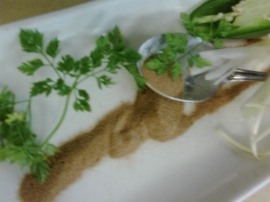Another Day in Poe's Kitchen at The Rattlesnake
Chef Brian Poe shows you the world in the back of the house.Archive for Recipes
My Multi-Talented Morel Vinaigrette
At Poe’s Kitchen right now we’re serving my take on an empanada: a puff-pastry square stuffed and baked with brie, then drizzled with morel vinaigrette. It’s a dish I’ve served to everyone from Curt Schilling (see here) to guests of the Legacy Dinner that marked the closure of Seasons in 2007, where I cooked with Lydia Shire, Jasper White, Peter McCarthy, and other fellow chefs of the legendary restaurant.

In fact, I’ve been tweaking it since around 2006; what I love about it is the versatility of the components throughout the year. For example, when beets are at their peak, I roast them in jalapeno and citrus and add them to the dish in paper-thin slices for garnish. I also switch the mushrooms in the vinaigrette depending on the season; there are grilled portobellos in the version I serve with my warm portobello salad (see the regular menu here).
Here’s the recipe for the dressing; have fun trying different ‘shrooms like I do!
Morel Vinaigrette
1 lb. morel mushrooms, cleaned
1 t. chopped garlic
1 t. chopped shallots
1 t. chopped fresh herbs (I like oregano, thyme, rosemary and basil)
2 c. olive oil
2 T. balsamic vinegar
Remove the stems from the mushrooms and sauté them in a pan; set aside.
Dip mushrooms into olive oil and shake off excess oil. Season with salt and pepper and sauté in the hot pan for about 5 minutes. Reserve juices and chop the caps with the stems.
In a mixing bowl, combine all remaining ingredients with a wire whip; add the diced mushrooms and juices. Reserve at room temperature. Can be refrigerated for up to one week.
An Eggnog Toast to You and Yours This Christmas!
Poe’s Kitchen will be closed tomorrow—but the bar in our heads is always open. After we put together a kickass Christmas playlist that put us in the mood, Lovewell—our assistant GM went to work with a bottle of Bailey’s Caramel and Absolut Vanilia as I got on a roll with the other ingredients, and we finished our creation, an adaptation of an old New York Times recipe, off with mint. No recipe today—but you get the picture!
Rattlesnake Eggnog
Yields 12 servings
1 qt. milk
1 qt. heavy cream
2 cinnamon sticks
1 vanilla bean, split
5 cloves
10 blades mace
12 egg yolks
1 & 1/2 cups sugar
1 & 1/2 cups Absolut Vanilia
1 & 1/2 cups Bailey’s Caramel
1 qt. half-and-half OR 1 qt. light cream OR 1 c. heavy cream plus 3 c. milk
1 T. vanilla extract
freshly grated nutmeg to taste
fresh mint leaves to garnish
Combine milk and spices, including vanilla bean, in a heavy saucepan and let them infuse over lowest possible heat for 5 minutes. Meanwhile, combine yolks and sugar in a large bowl and whisk until mixed.
Bring milk to a boil and gradually whisk it into the yolk mixture. Return the mixture to the saucepan. Cook over medium heat, stirring steadily with a wooden spoon, for 2 to 3 minutes, or until foam subsides and mixture thickens to consistency of heavy cream. (It should thickly coat the back of a wooden spoon.) Do not boil, or mixture will curdle.
Strain mixture into a large bowl and let cool to room temperature. Stir in vodka, liqueur, half-and-half (or equivalent), vanilla and nutmeg.
Refrigerate eggnog for at least 2 hours, preferably overnight. Just before serving, dust top of eggnog with additional nutmeg.
HAPPY HOOCH-FILLED HOLIDAYS!
Frigid Out There, Tropical in Here: The Beantown Mai Tai
We figured the obvious thing to do with Absolut Boston would be to highlight the black tea flavors to create a warming wintertime drink.
So we did the opposite. And look at the fun we’re having!

Beantown Mai Tai
1 oz. Absolut Boston
.5 oz Cointreau
.5 oz Myers’s rum
.5 oz apricot brandy
Combine in a cocktail glass and top with a splash each of sweet & sour and pineapple juice.
SHAZAM!!!!!!!!!!
You Asked for It: Prosciutto-wrapped, Blackened Tuna with Queso Fresco & Basil over Anaheim Chile–Corn Puree
Specifically, Behind the Burner asked for it, which means you can see me making it once the segment airs in January.

In the meantime, unleash your own cooking urges with the recipe below—or swing by Poe’s Kitchen and I’ll make it just for you!
Prosciutto-wrapped, Blackened Tuna with Queso Fresco & Basil over Anaheim Chile–Corn Puree
Yields 24 holiday hors d’oeuvres, 6 starters or 4 main courses
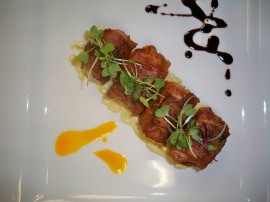
For the Anaheim chile–corn puree
2 c. fresh corn kernels
2 ears corn, grilled and sliced into coins
Olive oil
2 c. water, plus water for boiling
1 Anaheim chile, chopped with seeds
1/2 jalapeño, chopped & deseeded
1/2 t. shallots
1/2 t. garlic
Heavy cream
Salt and pepper to taste
Place fresh corn kernels with a touch of olive oil in hot pan. Add shallots, garlic, and water; reduce by 1/3.
Add kernels, along with cob coins, to a pot of boiling water. Allow to cook 5-10 minutes, then remove from heat.
Add chiles; place mixture in a blender and puree into a fine sauce. Add heavy cream as needed.
Strain the sauce and allow the cream to reduce by 1/3.
For the tuna
Poe-co Loco Dust
2 T. ground cumin
2 T. dark chile powder
2 T. paprika
2 T. garlic powder
2 T. dried oregano
2 T. ground coriander
2 T. white pepper
Combine all ingredients and reserve.
24 paper-thin slices prosciutto
24 basil leaves
24 oz. (about 2 lbs.) tuna filet, cut into 24 squares
24 thin squares of queso fresco (if you cannot locate this cheese, substitute fresh mozzarella)
Olive oil
On a cutting board, lay out sliced prosciutto.
Completely cover the tuna in Poe Co Loco Dust and place the seasoned tuna in the center of each prosciutto slice. Top with a leaf of basil and a piece of cheese. Wrap prosciutto around tuna and secure with a toothpick.
Heat oil in a saute pan and sear tuna for about 30 seconds per side, or until medium rare.
To impress your friends, spoon some corn puree onto a plate, then place the tuna on top and enjoy.
Let the Lime-Zested Chips Fall Where They May!

Some people have chips on their shoulders. Ever since I arrived at the Rattlesnake, I’ve had chips on the brain.
You see, the first thing I did when I walked in the door was look at reports to see what was selling and what was not, what needed fixing and what wasn’t broken. Back then, chips and salsa were the number-1 mover. So Gordon Wilcox and I went through 16 different salsas and countless corn chips on the theory that if we could perfect the simple things, you might trust us with more complex dishes. And our plan seems to be working. My favorite ticket from last night read:
Chips and salsa
Foie gras, hen of the woods, chervil and truffle pizza
In case you’re wondering why the following recipe calls for 3 different types of salt, there are 2 reasons. First, different textures increase the chances that the salt will stick to the surface of the chip. Second, salt crystals of different sizes retain the moisture from the limes better, which means they more easily recrystallize once all of the liquid is absorbed.
Lime Salt
Yields about 2 cups.
1/2 lb. kosher salt
1/2 lb. sea salt
1/4 lb. iodized salt
20 limes
Using a microplane or a small-holed grater, zest the limes, then split and reserve.
Combine the salts.
Mix in the zest and toss in the lime halves. Allow the mixture to sit for several days in a covered container before using—it’s also good on popcorn, seafood, and chicken!
Chip Seasoning
Yields about 1 cup
1 c. lime salt
1 t. ground coriander
1 t. powdered ginger
1/2 t. powdered onion
1/2 t. powdered garlic
1/2 t. powdered cumin
1/4 t. black pepper
Toss to taste on plain tortilla chips.
When Life Gives You Leftover Cranberries, Make Scallops!
With Thanksgiving over and Christmas on the way, I’ve got cranberries on the brain. But the beauty of New England is that there’s always something coming into season, and the window of opportunity I’ve got right now opens on another of my favorites—Nantucket scallops. Nantucket scallop season lasts from November through April. Only 10 bushels of scallops are allowed per boat, per day; it takes the scallopers about four hours to shuck their catch, and then it’s on a plane to me. Thanks to them, every bite of this dish smacks of winter on the Cape.

Nantucket Scallops with Basil Cream and Cranberry Salsa
For the Cream
1 c. sour cream
1/2 c. heavy cream
1/2 c. toasted pecans
9 basil leaves
1 pinch chopped fresh garlic
1 pinch chopped fresh shallot
salt and pepper to taste
Combine all ingredients in a blender; add a touch more heavy cream if too thick for your liking.
For the Salsa
2 t. dried cranberries
1 t. chopped celery
1 t. chopped fennel
3 leaves basil, chiffonaded
1 t. chopped pecans
splash of white wine
juice of 1/2 lime
Mix together and reserve.
For the Scallops
1 lb. Nantucket bay scallops
ca. 1 T butter
salt and pepper to taste
splash of white wine
upland cress (hydroponic watercress) for garnish
In a hot saute pan, melt butter, then add scallops. Allow to caramelize, season with salt and pepper, and deglaze pan with wine.
In the center of the plate, spoon a bit of the basil cream, top with the scallops, then add dollops of cranberry salsa. Garnish with cress and enjoy.
For That Most Wonderful Bipolar Time of Year: Chef’s Salad with Sage-Barley Vinaigrette
When I think of fall, I think of the smell of sage, which by November is one of the last herbs standing in my garden. Sage is a calming herb for me; historically, it has been believed to ward off evil and to aid in healing snake bites. I also think of barley—as in a good bowl of beef-barley stew with a hearty autumn beer. Hmmm… we might be on to something here? Sage…snakes…barley…bars…it all comes together in a vision of meals at Poe’s Kitchen that can ward off and warm up those first few evil cold nights.
Sure enough, it’s that funky time of year in New England when 60-degree sunshine alternates with freezing rain. Nothing evens out the weather’s bipolar disorder like a good pumpkin ale paired with an Indian-summery chef’s salad of Boston Bibb lettuce, eggs, Virginia ham, whiskey-cured bacon, Vermont cheddar, onions, tomatoes, and sage-barley vinaigrette. With the recipe for this dressing, just think of all the salads you can make at home to use up leftover turkey and undo some of the damage after Thanksgiving,,,
Sage-Barley Vinaigrette
1/2 c. sage leaves
salt and pepper to taste
1/2 t. minced garlic
1/2 t. mined shallots
1 c. olive oil
1/3 c. red wine vinegar
1/4 c. brown sugar
1/3 c. barley, cooked and reserved
Puree all ingredients except cooked barley with a mixer. Add barley and set aside, preferably for 24 hours.
Not for the faint of heart: Bourbon-Infused Bacon & Tasso Ham
We’ve been getting a lot of delightful, much-appreciated praise for our brunch special, the Bloody Mary & Bourbon Bacon Benedict. Or, to be more specific, the Bloody Mary–Infused Green Chile Cornbread Topped with House Cured, American Honey -& Whiskey–Infused Bacon & Tasso Ham, Queso Fresco, Guadalajara Butter, Bloody Mary, Vodka & Butter–Poached Eggs & Jalapeño Hollandaise.
If that sounds like a mouthful, wait until you taste it.
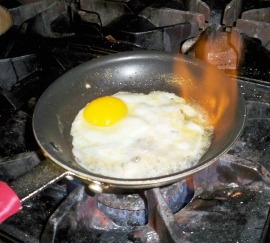
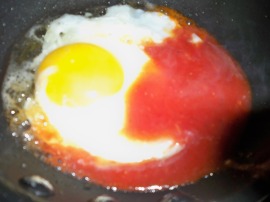
Your flaming, bloodied eggs are waiting!
Just how do you infuse bacon and ham with honey and whiskey? Funny you should ask, because I’ve got the recipe right here. All you need is a smoker and an attitude.
Obviously, this produces a whole heap of meat—but that’s the beauty of it: you’ll be in the pink all winter long. (If you want to reduce the yield, however, don’t hesitate to send a comment; I’ll walk you through the revisions.)
Honey & Whiskey–Infused Tasso Ham
5 lbs. pork sirloin
1 3/4 c. curing salt
1 1/2 c. white sugar
1 T. cayenne pepper
2 T. onion powder
2 T. garlic powder
2 T. ground mace
2 T. smoked paprika
1 T. dried sage
1 T. dried thyme
2 T. honey
3 c. Wild Turkey American Honey liqueur
3 c. Jack Daniels
Rub pork with all dry ingredients. Place on a roasting rack in a shallow pan. Spoon honey, liqueur and bourbon over the pork. Transfer the pork to a baking sheet and allow it to cure atop a wire rack for at least 5 days, pouring the pan juices over the top of the pork twice daily.
On the 5th day, dry smoke the pork for up to 12 hours with mesquite and applewood chips at 165 degrees.
Honey & Whiskey–Infused Bacon
1 pork belly
1 3/4 c. curing salt
1 1/2 c. white sugar
1 T. cayenne pepper
2 T. onion powder
2 T. garlic powder
2 T. ground mace
2 T. smoked paprika
1 T. dried sage
1 T. dried thyme
black peppercorns and coriander to taste
2 T. honey
3 c. Wild Turkey American Honey liqueur
6 c. Jack Daniels
Season the pork belly with dry rub and allow it to rest for one day, turning it over halfway through. Then cut the belly into workable bacon-size blocks, about 5 x 5 inches. Season with black peppercorn and coriander, then place into a large plastic container. Pour all of the alcohol and honey into the container, cover and allow to brine for up to 4 days.
On the 5th day, remove pork belly from brine and hang for the rest of the day to dry.
Then cold smoke the bacon for up to 12 hours. Slice thin and cook to order.
You know what we do with it at Poe’s Kitchen once it’s ready—but what will you do? The possibilities are endless. Tell me all about them!
Snake, Rattle and Roll: Serrano-Infused Rattlesnake Cakes with Mango-Jalapeño Puree
Walking into the kitchen at the Rattlesnake was one of my riskiest career moves. Still is…Not because I have to deal with the Rattlesnake, capital R, but because I have to deal with the rattlesnake—small r. It comes special delivery from Arizona via Jersey.
No, no, it’s not live. Its head has been removed; decapitation is the first step of “harvesting” rattlesnake, because there’s some evidence that the head can still strike for up to two hours after its removal. Makes your skin crawl a little, doesn’t it? Mine too, but don’t worry, it gets better…in fact, it gets delicious!
Early on I did a bit of polling to see what people wanted out of the Rattlesnake to make sure Poe’s Kitchen reflected that. The consistent answer: “This place would be a lot cooler if it actually served rattlesnake.” Passersby on Boylston would regularly ask the doorman: “Do you guys serve rattlesnake?” I had to get my hands on some—and we had to do with it what we try to do with everything else on the menu: ensure it’s of excellent quality and prepare it simply so that the goodness comes through.
Back in Arizona at the Pinon Grill, I served rattlesnake, but it came already ground up, so all I had to do was mix it in with other ingredients. I searched for my old purveyor, but for some reason I could not find him. It took me three months to even locate the product again—and I mean, I looked five times a day the whole time. When my friend Lance from Fossil Farms finally came through for me, he told me that the reason I couldn’t locate anything online was because the gentleman that hunted and gathered the snakes was bitten—and therefore out of commission for a while!
So when the first delivery arrived, I wanted to be the guy to open the box. I couldn’t wait to get my hands on it, after dreaming for months about what I would do with it. I cut the box open and dug through the Styrofoam. Then suddenly I felt it—and saw it. Instantly I jumped! Frozen on the bone and perfectly coiled in a clear Cry-o-vac bag, it naturally gets the adrenaline going. In other words, I freaked out for a minute.
It’s on the prep table, though, that snake becomes the most bizarre thing I’ve ever cooked. I had decided to marinate the snake in buttermilk and cilantro for 24 hours. The next day I pulled it from the marinade to check it and suddenly, half the body moved. It was because of the way it was attached to the bone, but I couldn’t shake the feeling that it was alive—or the pain in the back of my neck from freezing up with fear!
We cooked the snake at a very low simmer for about an hour in a fresh batch of buttermilk, adding cilantro as it cooled so the flavors would infuse, then spent another hour cleaning the meat from the multitude of bones with a fork. The best way, we agreed, to reduce the shocks I’d gotten during prep was to make rattlesnake cakes.
I was a little reluctant when I put the dish on the Unleashed menu—was it too weird? Would anyone order it? So I offered it as a one-ounce taster—and we sold out in three days! Now we sell roughly 70 orders a week (that’s about 2.5 snakes worth!) This past week, we sold out on Thursday night around 9 pm. We prepared more for Friday-night service and within two hours we sold out again! Tables on the roof deck were ordering six at a time, all on one plate. I’ve finally put the cakes on the regular menu due to the high demand. So get here early, because these snakes move fast!
Serrano Chile–Infused Rattlesnake Cakes with Mango-Jalapeño Puree
Makes about 15. Can be made with crab instead of snake if desired.
For the cakes:
2 lbs. rattlesnake (or lump crab)
1 each red, green, and yellow bell pepper, diced fine
2 serrano chiles, diced fine
1 bunch of cilantro, chopped
1/2 c. red onion, diced fine
1 c. Ritz cracker crumbs
2 eggs
1 t. Habañero Tabasco
Combine all ingredients well and form into 2 oz. cakes. Reserve in the refrigerator until ready to cook.
For the mango-jalapeño puree:
4 mangos, peeled and deseeded
1/2 t. garlic
1/2 t. shallots
1 bunch cilantro, rinsed
2 jalapeños, chopped and seeded
1/2 c. hazelnut oil, or 2 t. fresh hazelnut if available
1/2 c. brown sugar
1/2 c. white wine (I suggest a J. Lohr–style riesling)
1/4 c. lime juice
Combine all ingredients in a blender and puree until smooth. Reserve.
Preheat the oven to 350 degrees. Cover the base of a large, hot sauté pan with a small amount of olive oil. Sear the cakes for about 1 min. per side, then place in the oven for about 8 min. more.
On the base of a large platter, pour the puree, then place the cakes on top and drizzle a bit more sauce over them. Now you’re ready to snake, rattle and roll!
Charting the Heat in Poeville Units: a few words on jalapeños and habañeros (+ recipes!)
Scoville units were developed during a 1912 experiment in which a sugar-water solution was sprayed on the tongues of chile tasters until the capsaicin—the “heat” of a pepper—could no longer be detected. The ratio of capsaicin to sugar-water determined the number of Scoville units. So, for instance, a bell pepper measures 0–300 Scoville units; a jalapeño is 10,000–15000 units; a habeñero is 100,000–300,000 units. (Here’s a good example of the Scoville Scale.)
Poeville units are what I’m developing in my own kitchen. At one end of the scale is the jalapeño, which I compare to a jog on a treadmill in a gym without air conditioning. It’s uncomfortable, but escapable; the discomfort will go away soon enough. At the other end is the habañero, which is more like a full marathon run barefoot in pure humidity on scorching asphalt. You think you might die, but you keep chasing that runner’s high anyway.
Jalapeños hail from the city of Jalapa in the Mexican state of Veracruz. They also come from Oaxaca, Chihuahua and the border regions of the Southwest. In their smoked form, they are known as chipotles. I choose to play with these little green devils in dishes like my jalapeño clam chowder
because I can control the heat level to the point that most customers can handle—just enough to make them break a tiny sweat. Bite into a jalapeño and you’ll get a hint of green bell pepper at first, with the heat cranking up slowly. Take a spoonful of the chowder, and the creamy comfort of the clams and potatoes will keep you in New England until the last minute, when that last little jolt reminds you that you are really in Poe’s Kitchen—the no man’s land between New England and Latin America!
For chowder eaters who can take a little more pain, we make jalapeño powder by slicing the peppers and dehydrating them overnight.
Then we puree the dried, super-concentrated pods into a powder and sprinkle it sparingly over the fried clams that accompany the chowder just before serving.
As regulars develop a tolerance and come in search of even hotter dishes, I treat them to the more tropical but meaner habañero (meaning “from Havana”). It is one of the hottest of any of the chiles grown in Central America and the Caribbean. In fact, it’s 50 times hotter than the jalapeño and should be handled with gloves, because it can even irritate the skin. Because it has citrus undertones, we pair it with Mexican shrimp, which we marinate with cilantro in Narragansett beer, then top off with a straightforward habañero puree. (Check out the gallery for a glimpse.) This dish comes with a warning label, two more warnings from the server and an advisory beer or three for the brave souls willing to jump into the firepit! After taking that leap, one guest of mine paced in front of the restaurant for 20 minutes, cursing me and the peppers too. But when I went to check on him, he laughed and said, “It just tasted so good I couldn’t stop eating it!”
Here are the recipes for both the powder and the puree. Use them wisely! By the way, one of my all-time favorite reference books on chile peppers is The Great Chile Book by Southwestern cuisine pioneer Mark Miller. The book can be viewed in its entirety here.
Jalapeño Powder
15 jalapeños yield about 1/2 c.
Destem peppers and cut in half lengthwise. Place in a Ronco-style dehydrator for one day, rotating the bottom tray to the top every 2 hours until all jalapeños are dried. Place in a blender or spice grinder and puree until a fine powder is formed. Can be stored indefinitely.
If you do not have a dehydrator, place the jalapeños on a cookie sheet atop a baking rack. Set oven at lowest possible temperature and place tin the oven. Check every hour until peppers are dried. In convection ovens, this can happen in about 2 hours. In others, it can take 5 hours. Just keep checking!
Habañero-Citrus Puree
Yields 2 cups or about 20 servings
1/2 c. orange and red habaneros
1 c. high-quality extra virgin olive oil
Juice of 2 limes
1/4 c. rice wine vinegar
Destem the peppers and halve them lengthwise; whether you remove the seeds depends on your taste for danger! Combine all ingredients and puree in a blender. Refrigerate until needed; it can keep about as long as your average condiment.
